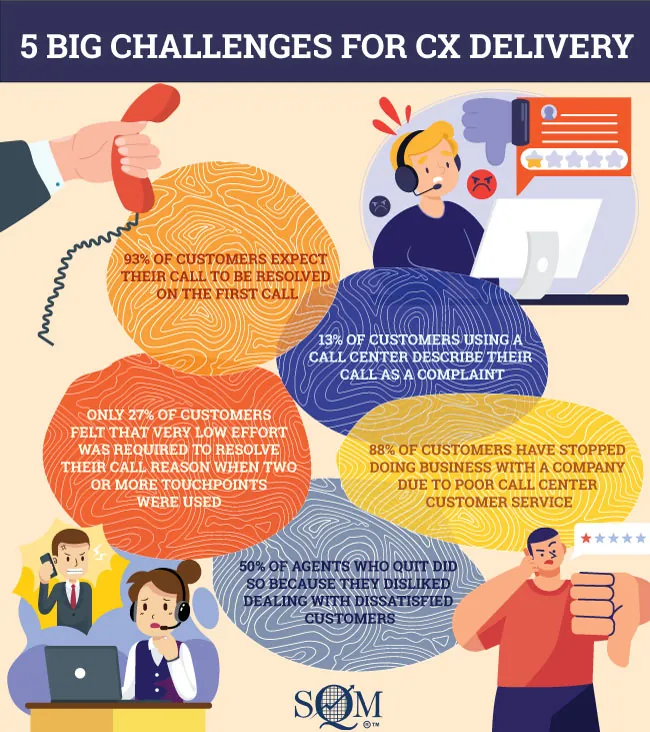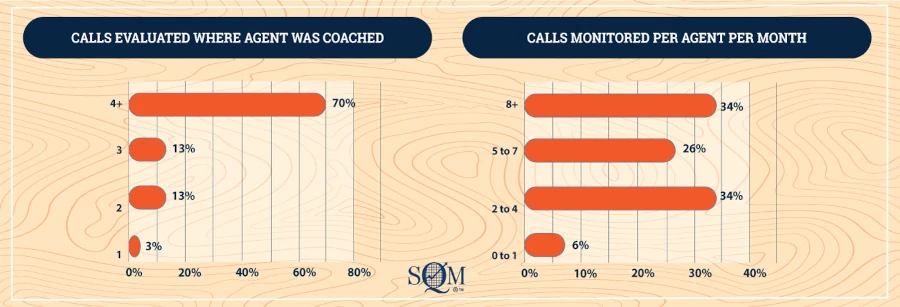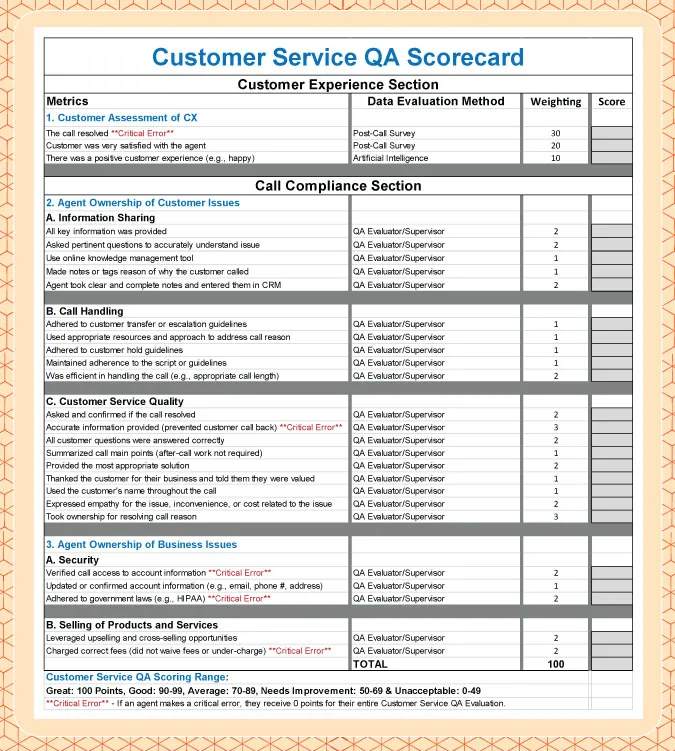Many leaders believe that their call center scorecard is effective for evaluating and measuring quality assurance (QA) scores and helping them achieve good customer satisfaction (Csat) and business needs. But are the call center scorecards used effectively for meeting customer and business needs?
Most call centers strive to excel at achieving a QA scorecard that meets the customer and business needs, but based on SQM Group conducting over 500 customer service benchmark studies with leading North American call centers, only 5% of them provide world-class Csat and First Call Resolution (FCR). However, QA scorecards have had more success in meeting business needs (e.g., regulatory guidelines).
You can make a strong argument that there is a tremendous opportunity for companies to create a call center scorecard that more effectively evaluates QA scores for meeting customer needs while also meeting business needs.
In this blog post, we will explain what a call center scorecard is, its importance, and how to create a call center scorecard for meeting business and customer expectations.
1. What Is a Call Center Scorecard?
The call center scorecard name is referred to by many names, such as agent dashboards, QA scores, quality assurance scorecards, and customer service QA or CQA scorecards, to name a few. However, the below call center scorecard definition applies to all the referred names.
A call center scorecard is used to evaluate if the customer and business expectations are being met based on using up to 25 predetermined questions. With the use of a call center scorecard, supervisors can see their agent's QA score performance and areas they need coaching on to improve to meet customer and business expectations.
The call center scorecard is typically used at the agent, supervisor, and call center levels. The data sources used as the input for evaluating call center scorecards include post-call surveys (e.g., up to 5 questions) and QA evaluators (e.g., up to 20 questions). The call center scorecard insights are used for agent coaching, training, and making the necessary people, processes, policies, and technology changes.
2. Why Is the Call Center Scorecard Important?
Implementing an effective call center scorecard helps make agents and supervisors accountable for delivering the required call-handling behaviors and key performance indicators (KPIs) and identifying improvement opportunities for effectively and efficiently handling calls. Furthermore, understanding call center scorecard gaps in performance help determine where agent coaching and training are needed. On the other hand, call center scorecards can be used to recognize agents who achieved high QA scores.
The call center scorecard is important because it can help improve CX challenges:

- 93% of customers expect their call to be resolved on the first call; however, 30% of calls are not resolved on the first call, and 12% of calls go unresolved.
- 13% of customers using a call center describe their call as a complaint, and only 41% of complaint callers are very satisfied with how the agent handled the call.
- Only 27% of customers felt that very low effort was required to resolve their call reason when two or more touchpoints were used to resolve the same call reason.
- 50% of agents who quit did so because they disliked dealing with dissatisfied customers.
- 88% of customers have stopped doing business with a company due to poor call center customer service.
The benefits of using a call center scorecard for agent coaching are:
- Provides agents with the necessary call behaviors and KPIs expectations
- The call center scorecard lets an agent know how they are performing
- Ensuring government regulatory guidelines are adhered to
- Provides agent performance insights and coaching opportunities
- Higher Csat scores and FCR
- Lower call center operating costs
- Improved ROI for call monitoring
- The ability to monitor agent progress
- Higher agent job satisfaction
3. How to Create and Use a Call Center Scorecard?
Below are the top 10 tips for creating and using a call center scorecard.
1. Determine the Overall Call Center Scorecard Goals
The starting point for creating a call center scorecard is determining the overall goals. When creating a call center scorecard, it is helpful to develop call-handling agent behaviors and KPIs associated with the following two variables:
- What are the business needs expectations?
- What are the customer expectations?
Another common goal for the scorecard is to use it for tracking, benchmarking, and improving agent performance. Whatever your call center scorecard goal is, it is essential that you make it clear to all stakeholders what the goals are and how they are performing toward meeting those goals.
2. Ensure Your QA Program Has the Best Ownership
Once the quality assurance goals have been determined and approved, you are ready to assign ownership to manage the QA program. If possible, a good practice is to have the most successful or one of the top call center managers for QA scores assigned to managing the call center QA program.
Having someone specifically in charge of the QA program will help ensure the department will operate effectively and efficiently to achieve customer and business needs. Conduct regular calibration sessions with QA evaluators to ensure consistency of QA scores and call center scorecards.
3. Seek Agent Feedback for Creating a Scorecard
To ensure the call center scorecard is effective for meeting customer and business expectations, seek agent and supervisor input for creating the scorecard. These stakeholders are the most knowledgeable about the call handling experiences and are likely to have suggestions for behaviors and KPIs that are needed to be able to meet customer and business expectations.
Furthermore, by seeking and using agent and supervisor feedback, you are also more likely to have frontline commitment and motivation for frontline employees to achieve call center scorecard goals.
4. Incorporate Customer Feedback into the Call Center Scorecard & Coaching
Educating agents and supervisors on the call center scorecard philosophy of using post-call surveys and business needs data to evaluate calls for agent scorecards is essential. Getting the agents and supervisors to buy into the call center scorecard approach for evaluating calls is vital for success.
The criteria for evaluating a call is the customer completed a post-call survey, which is a random approach for determining calls that will be assessed for the call center scorecard. All customers who phoned the call center should be eligible to participate in a post-call survey. A post-call customer survey must occur within one business day of the call center interaction.
The post-call or email survey should focus on quality metrics that the customer can judge, such as their satisfaction with the agent and whether their call was resolved. A CQA program should collect surveys randomly, with equal distribution of surveys throughout the month. A minimum of 5 surveys per agent per month is collected to conduct a customer quality assurance evaluation.
SQM Group's research shows that for the call center industry, calls monitored per agent per month is 60% of call centers evaluate five more calls. Furthermore, 71% of call centers say they coach an agent on four or more calls that have been QA evaluated.

5. Choose the Right Agent Behaviors and KPIs
Choosing the right agent behaviors and KPIs is essential for ensuring that your call-handling practices are meeting the customer and business expectations. Most supervisors and agents believe that the call center scorecards are the most vital reporting information they view to help them improve their QA scores and Csat performance.
A call center scorecard can help track, benchmark, and improve customer service QA delivery. In addition, the call center scorecard and complementary reports provide insights for analyzing CX and business data over some time. Customer service delivery affects the company's operating costs, brand image, revenue, customer referral, and retention. Therefore, considering tracking customer and business KPIs and metrics such as:
- Total Customer Service QA score
- Customer Satisfaction Score
- First Call Resolution
- Call Resolution
- Customer Sentiment
- Average Handle Time
- Average Hold Time
- Number of Escalated Calls
- Government Regulation Adherence
6. Create a Call Center Scorecard
Create a customer service QA dashboard scorecard or sometimes referred to as CQA, to meet business and customer expectations. A CQA scorecard evaluates and scores agents on behaviors and KPIs related to achieving business needs and customer expectations.
The CQA scorecard uses a grading rubric for your agents to understand their performance and coaching opportunities to improve. If an agent meets all the CQA criteria on the scorecard, they have successfully delivered great CX while also meeting the business needs.
The customer service QA scorecard can provide your call center with outstanding CX and business insights. Agents can deliver great customer service and meet business needs with the proper guidelines and metrics that are appropriately weighted. When the right CQA metrics and guidelines are in place, agents are coached to them, and agents follow them, FCR and Csat will improve.
When a call center uses the right CQA guidelines and metrics, agents appreciate using the CQA scorecard because it identifies strengths to build on and weaknesses to develop. Therefore, in many cases, they get high customer service QA scores when they follow the guidelines and standards.
Furthermore, if agents meet the criteria of the CQA scorecard, they know what is expected of them and how to achieve it, which creates job satisfaction and reduces anxiety and stress. Below is an example of a call center QA scorecard designed to meet business needs and customer expectations.

7. Choose Call Center QA Scorecard Software
Choose a call center QA scorecard software that provides a comprehensive and customizable data visualization reporting scorecard from the agent to the call center level. In addition, it can display the KPIs and behavior metrics that assist agents, supervisors, and managers in achieving customer service and business needs goals.
Furthermore, the call center scorecard is used to discover emerging trends and monitor and optimize customer service and deliver business needs by providing the right agent coaching and training based on scorecard insights. In addition, the scorecard can also generate reports that provide viable insights to develop an action plan for improving the call center's ability to meet customer and business expectations.
Below are some of the features of an effective call center QA scorecard software:
- Customizable Agent Scorecard Dashboard
- Data Visualization KPI Graphics
- Powerful Widget Features
- Actionable Customer and Business Opportunity Insights
Request a mySQM™ Customer Service QA Demo Video
Learn about SQM's agent… CSAT prediction model, which is based on standardized metrics, AI, and regression analysis to predict customer satisfaction derived from a QA evaluation. Our CSAT prediction model provides a high statistical correlation, translating to a 95% success rate in predicting agent CSAT in most cases.
8. Conduct Test Pilot Call Center Scorecards
To ensure the call center scorecards are effective for meeting customer and business needs, conduct a test pilot before rolling it out to all the agents. A small test pilot of 2 to 5 supervisor teams can be an effective approach to iron out any issues with call center scorecards.
Furthermore, the test pilot will allow you to make any necessary adjustments to the call center scorecards before creating agent and supervisor accountability and using the scorecards to improve and reward their performance.
9. Check Call Center Scorecard Progress
Schedule agent coaching sessions to review their call center scorecards. These sessions can send a powerful message that a supervisor cares about their progress and wants them to be successful.
Most call centers provide monthly scorecards to agents and supervisors to check their progress toward achieving customer service and business needs goals. Furthermore, many large call centers provide weekly scorecards to agents and supervisors to ensure that they are focused on meeting customer and business needs.
However, it is important to make sure agents consistently receive feedback on areas identified as improvement opportunities and check call center scorecard progress for improving the areas identified as customer or business issues.
The supervisor should provide the agent feedback on specific positive behaviors and behaviors that still need improvement. It is important to remember that most agents want to achieve high call resolution and Csat performance. Supervisors need to share best practice calls and tips for improving the call types and call reasons that the agent struggles to achieve high performance and then check their progress.
10. Evaluate the Effectiveness of the Call Center Scorecard
To ensure a company is maximizing the effectiveness of the call center scorecard, you need to evaluate it periodically. It is extremely important to solicit agent and supervisor feedback about if the call center scorecard helps them meet customer and business needs and expectations.
Based on the feedback of agents and supervisors about the effectiveness of the call center scorecard, make the necessary changes that are required. If the changes are large, consider testing the changes in a small pilot group to ensure it has a positive impact on meeting the customer and business expectations.
